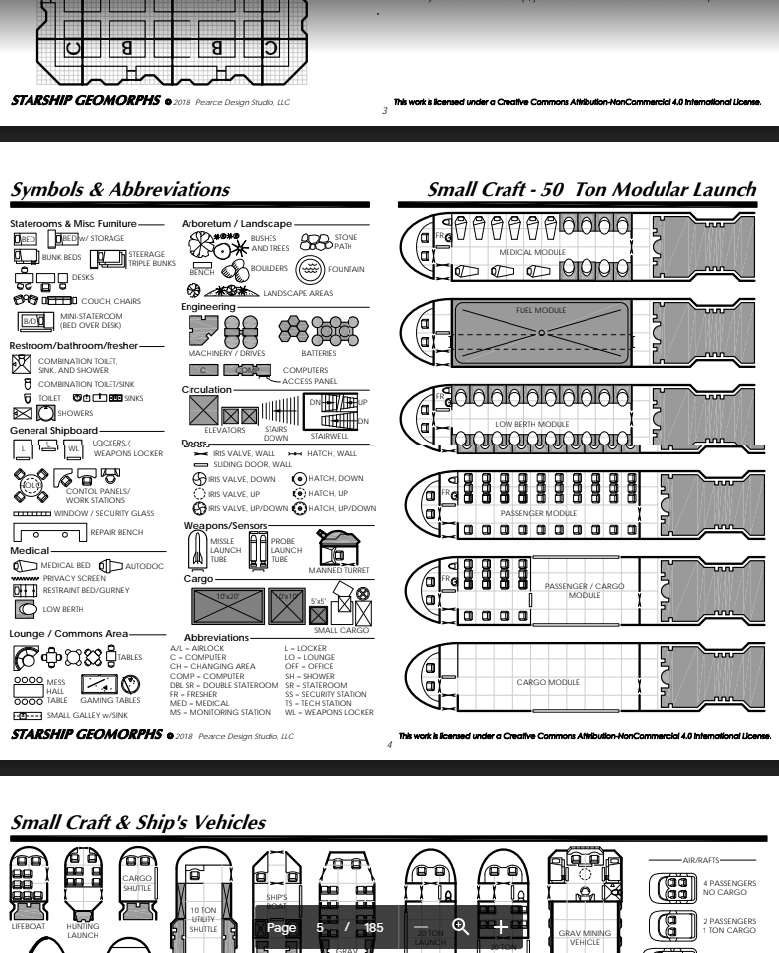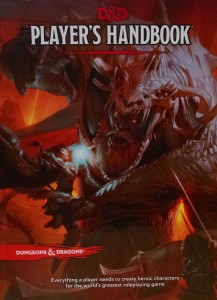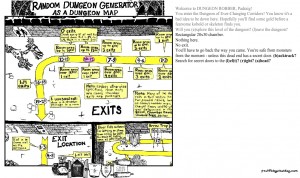GaryCon X
This last weekend I went to GaryCon up in beautiful, chilly Lake Geneva Wisconsin, and I had a great time! I met up with old friends and made some new ones, and we all played a bunch of games and enjoyed the great company. Here are some highlights from the con for me.
Games
I ran a session of Vampyre Women of Venus, the board game that we put out a couple of years ago. We had two ticketholders show up and one player drop in, thanks to the great table flag system. We played though to the co-operative victory and then played some homebrew rules that Jayden came up with for the post-rocketship-part-collection escape from the suddenly moving Vampyre Queen.
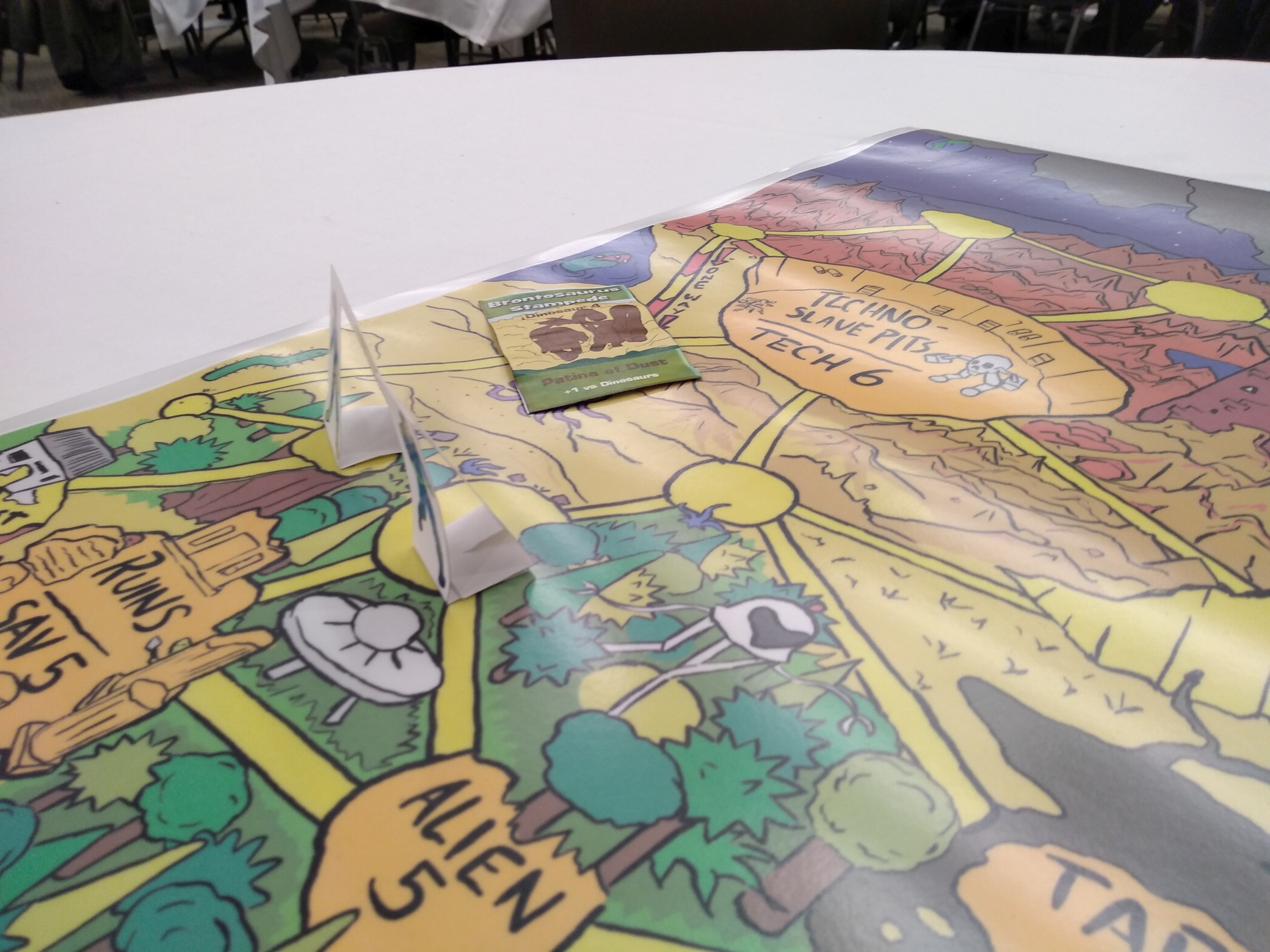
All told I got some great new ideas for the game, including a new version of the rules where undefeated Venus cards remain in the space where they were drawn for other players to try to challenge. This builds the map as it is explored and creates more opportunity for strategy.
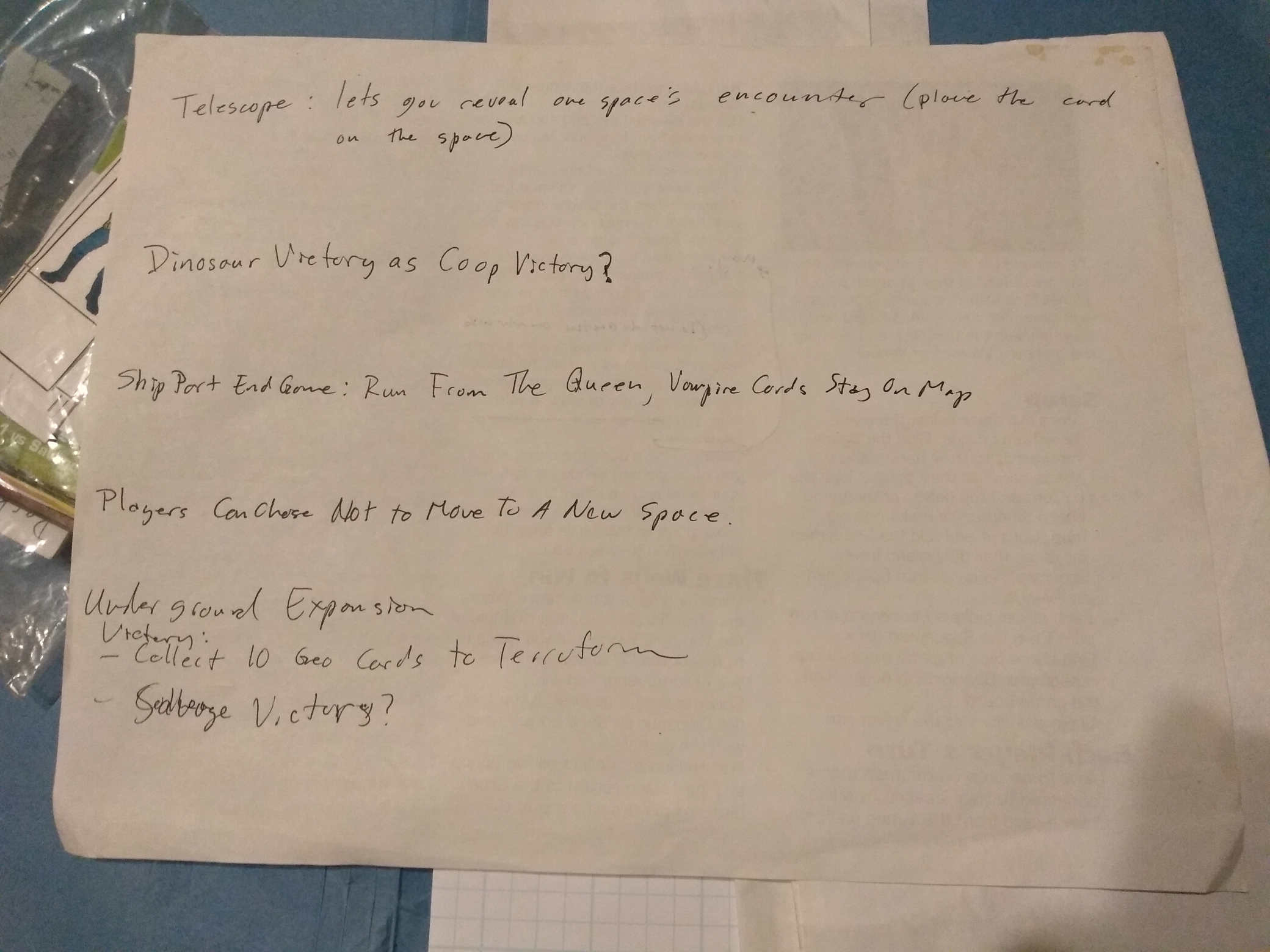
I also ran a session of what’s becoming my favorite scenario: my D&D convention version of Into The Unknown (B1), which I update every time a group runs through it. This time, very impressively, the group actually managed to complete the scenario, both finding their way to the final encounter and defeating all portions of it for a flawless victory! Well done, all. Prizes are on the way.
Table Flags
One of the best things about the convention, and something I hadn’t ever seen at one, was the table flags. These flags served two purposes. First, there were red and green cards so that a table could indicate if they had any openings for new players to join.
But even more exciting was the yellow flag, which we raised when we wanted to order from the tableside menu. The food was really good, and the beer was cold and cheap with the GaryCon cup I got as a GM. It was truly excellent. I ran an eight hour session and ate healthily and felt great.
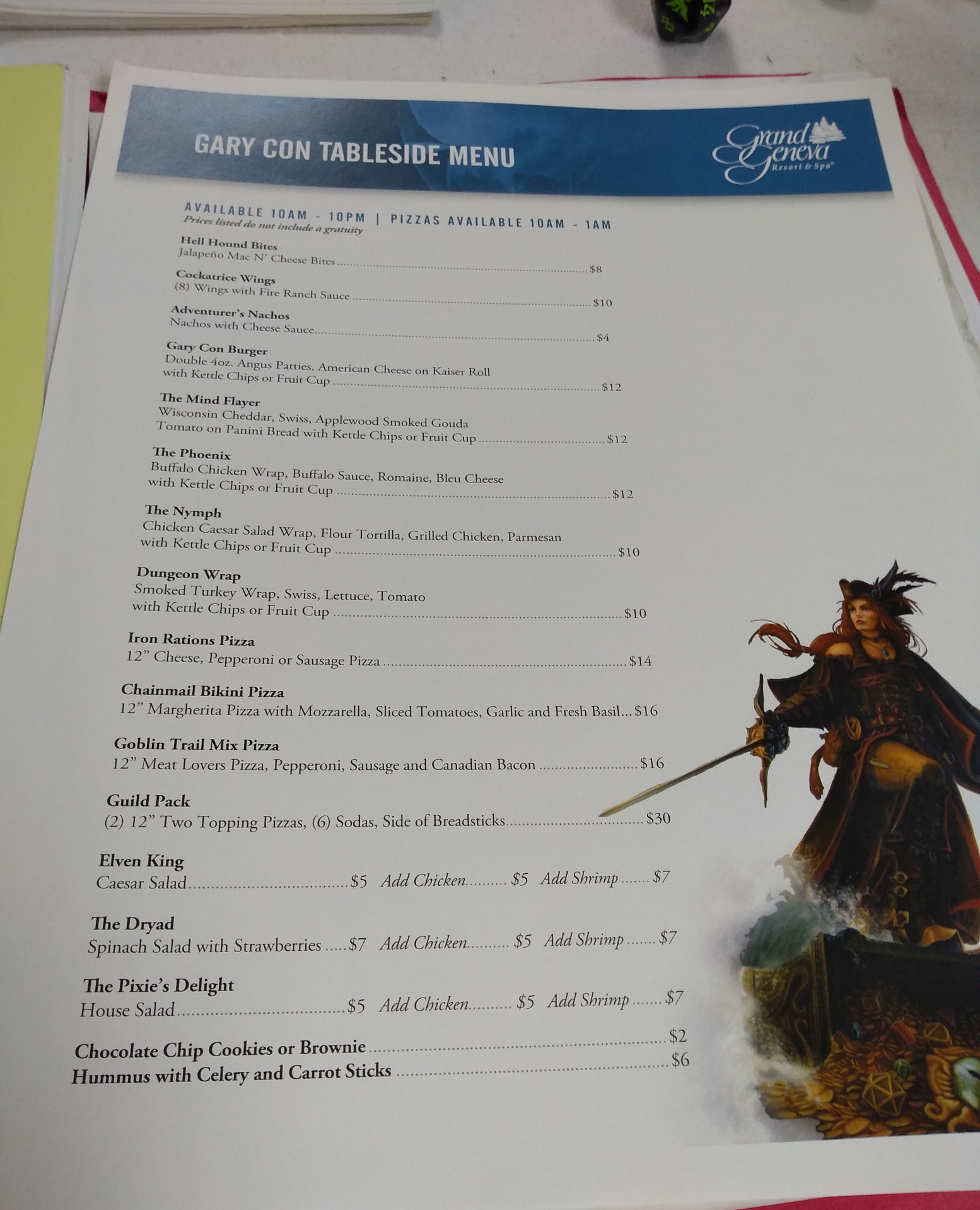
Museum
The role-playing game history museum they had set up was AMAZING! In the wargame room, next to the TSR Joust tournament, was a mini-museum display with great information about the early days of Dave Arneson and Gary Gygax’s gaming days. Seeing Arneson’s original dice and clay dragon figurine really touched me.
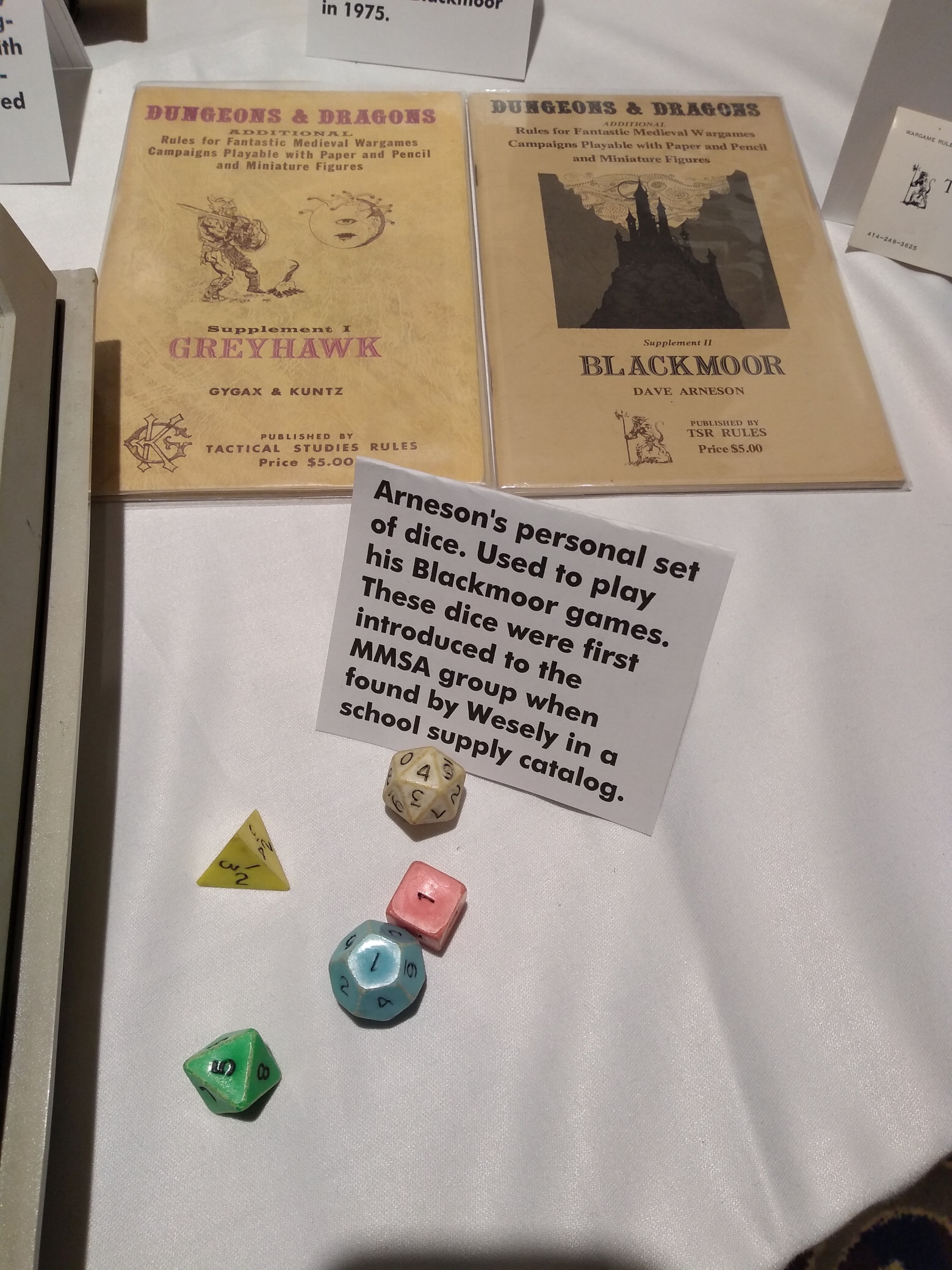
Socially, I got to hang out with Stephan Porkny and the HawaiiCon crew, meet a whole bunch of nice new people, and see some live-streaming celebrity D&D from behind the curtain, instead of in front of the cameras for once. It was great seeing everyone and hanging out. As it always is for me at a con, I learned a lot from playing in and watching other people’s games.
I’m honored to have been invited and have already booked accommodations for it again next year.
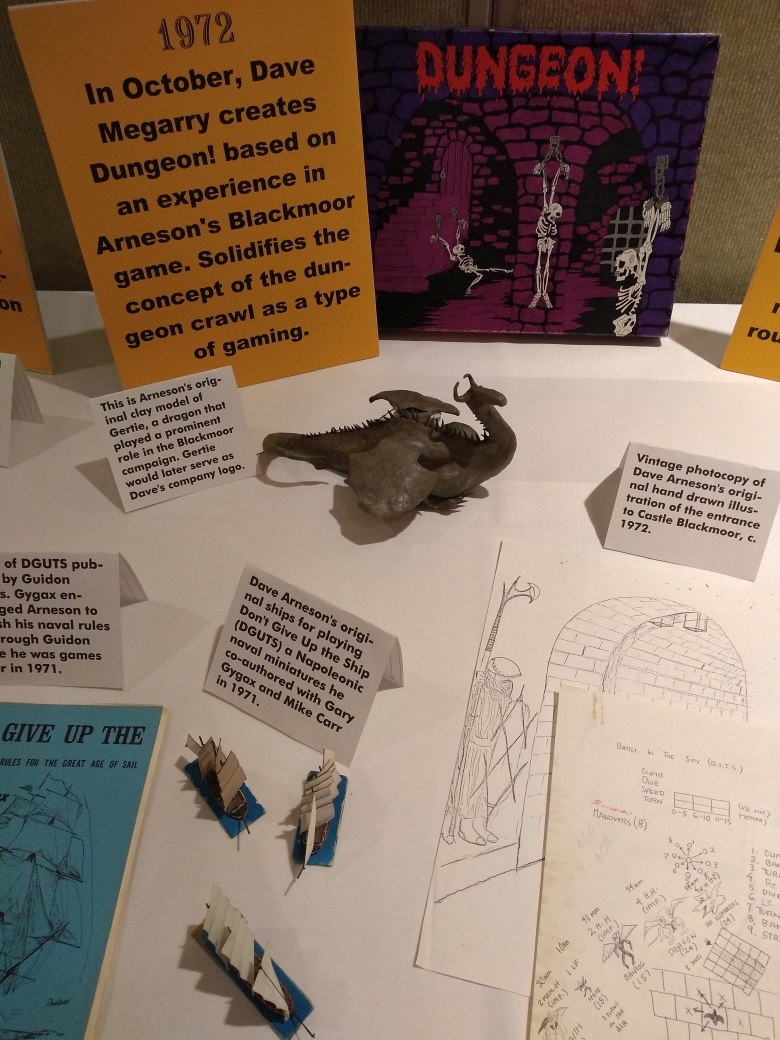
Posted in convention, Review and tagged GaryCon by Adam A. Thompson with no comments yet.
Review: Starship Geomorphs
Robert Pearce‘s new Traveller suppliment Starship Geomorphs is a huge new resource for science-fiction gamers, filled with beautiful illustrations, hundreds of starship deckplan geomorphs, and most importantly, really good suggestions for using these modular maps in your home game. Designed to be used to quickly generate starship and spaceport maps, these geomorphs also provide inspiration when designing deck plans for new ships.
Representing three years of painstaking work, this beautiful 185 page book is a great resource for any science-fiction role-player, and he’s made it available as a free download! I recommend it highly to any sci-fi gamemaster, or anyone who wants to design starship interiors.
Included in the free guide are instructions for printing these maps out to use in your home game for both 15mm and 25mm scale miniatures.
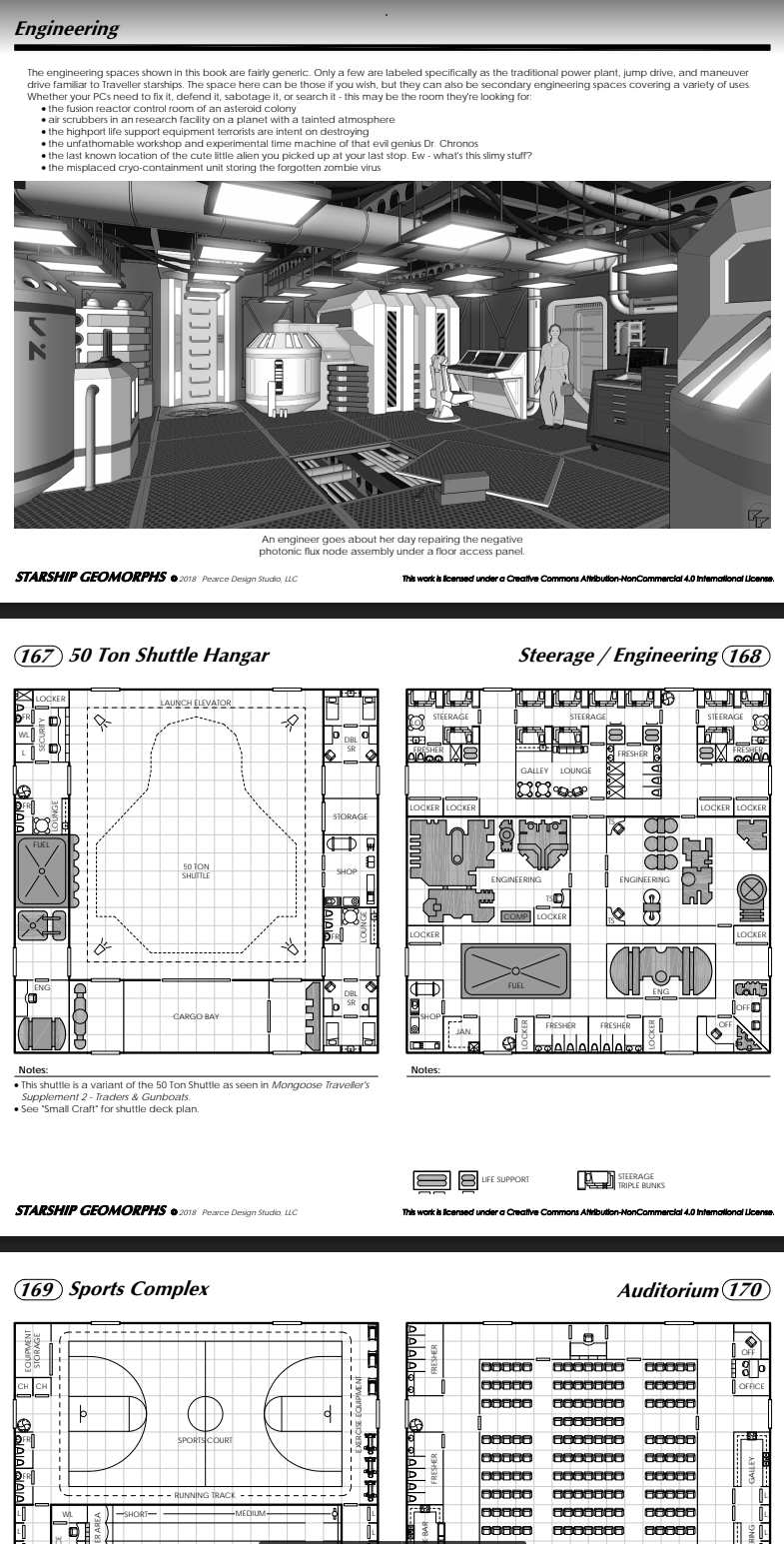
This wonderful resource also includes maps for areas one doesn’t usually see in deckplans, like recreation areas, many different common areas, shopping areas, arboretums, viewing galleries, and even agricultural spaces. I will definitely be using these to build out starports and megaships in my Traveller game.
Posted in Editorial, Review, Science-Fiction, Traveller by Adam A. Thompson with no comments yet.
Regarding Characters – The Wounded
I liked Mad Max – Fury Road quite a lot. There’s been a bit of discussion about it, which I find refreshing. I’m really happy to have something to say about a major motion picture other than, “Wow, another wooden, formulaic, plodding Hollywood film.” Having seen it twice the thing that sticks with me is the detailed, understated writing. One place where you see this in the the characters. Furiosa, Max, and Immortal Joe all have interesting, well-developed characters.
Think about the journey that Max’s character makes – he goes from being a completely anti-social animal to reconnecting with people around him. It’s not a character journey you see male leads play very often in film. Hurt Locker was similar in some ways. Sometimes a child’s character goes through something similar, like Newt’s character in Aliens. It is a compelling and timely story. In an age of endless global war the archetype is both familiar and incomprehensible.
Here he is, a person brutalized by living at the edge of his wits for ?? years. Major damage. PTSD or ghosts. Loss. Betrayals. Whatever happened to all those kids that he escaped Barter Town with. After all that he’s in bad shape psychologically. Remind you of anyone? John Rambo? Your buddy who went off to war in central Asia and came back all fucked up? Yourself? Fury Road holds a mirror up to our faces, but it’s not a reflection that we see very much on the silver screen.
Conversely, the character many expect to see in Max is played by Furiosa. She is like Max’s character in the first movie – she sees that shit’s fucked up and she decides to take matters into her own hands. She conspires with the other women, steals a war machine, and makes a break for it. A warrior turned outlaw, according to the laws and traditions of Immortal Joe’s Citadel. She too has had years of trauma, but she is active, while Max is reactive. It’s a reversal of traditional gender rolls. Also, as a person with a prosthetic hand, Furiosa is another warrior who has been wounded.
It’s a role that seemed a bit odd to me when I first saw it, as I hardly ever see it portrayed. Or at least not by male characters. Is that what has some people complaining about this film? The fact that Mad Max’s character isn’t some heroic superman? To those who decry this movie, my question is, “Have you even been watching these films?”
As a fan of film I was interested by how Fury Road’s departure from the seemingly-omnipresent narrative played out. I liked it quite a lot. And it was totally metal. Five horns up.
\m/. \m/. \m/. \m/. \m/.
Posted in Editorial, Review by Adam A. Thompson with 1 comment.
Dungeons & Dragons 5th Edition – First Impressions
Welcome – I am proud to announce that this review of the 5th edition Dungeons & Dragons Player’s Handbook is the 750th post on Claw / Claw / Bite!
In addition this is the inaugural post on the new blog and website. The server hosting this blog went down a few months ago. Due to incomplete backups we have had to rebuild a several years of the blog one post at a time. This has only been possible due to the Internet Archive‘s captures of the original blog. Thank you, Internet Archive, you were my only hope. With the help of those captures the many years of our creative works are once again available to the public.
To introduce myself – I’ve been playing Dungeons & Dragons since 1982 or so, and I’ve been publishing material for role-playing games through Unicorn Rampant since 2006. You can see the fruits of our labors here. Feel free to leave comments here on the blog, and expect this new site to continue to evolve and change as we clean up from the move and reconstruction.
I’ve been reading the 5th Edition Dungeons & Dragons Player’s Handbook from cover to cover in preparation for playing and writing material for the new rules. As someone who has already played more than 5 different versions of this game, along with many other role-playing games, I’m very interested in how well this new edition of gaming books are written, and how fun the game looks to play.
My summary? The new edition of the Player’s Handbook is well done, both for new players and those of use who have been loving this hobby for a long time. A few of the best ideas from 4th edition have been baked into a streamlined, inspiring, familiar-feeling new edition of Dungeons & Dragons. Clear, evocative writing illuminates character options and rules throughout, with a healthy dose of illustrative art, and fun tables and charts.
Reviewing the table of contents, I’m glad to report that they have more or less kept the same order of chapters that has been in use since the AD&D Player’s Handbook. The 5e D&D PHB has that same sensible old order of topics that make it a quick and easy-to-use resource for a veteran player like me: Characters, Equipment, Rules, Spells, and Appendices. There is also an extensive index.
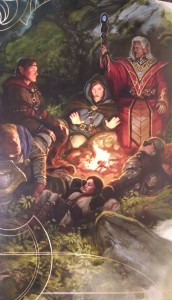 The Player’s Handbook is graced throughout with a generous amount of varied art. Realistic-looking pieces gaze across the page at more illustrative ones, and everything is vividly colorful and well executed.
The Player’s Handbook is graced throughout with a generous amount of varied art. Realistic-looking pieces gaze across the page at more illustrative ones, and everything is vividly colorful and well executed.
The introduction lends good context to what this strange game is, with evocative cues for the imagination throughout. For new players this section of a role-playing game rule book is hugely important – not just to summarize how the game is played but to give the reader an idea as to why it is played. If a prospective player reads the fist page and it doesn’t make sense, or if it just falls flat, then that reader might miss out on this incredible game.
The worlds of Dungeons & Dragons are presented as individual creations with similarities, and the official settings of Greyhawk, The Forgotten Realms, and Dragonlance are used for examples throughout. Thus the reader is presented with a rich variety of inspirational details while being encouraged to create their own unique game.
The character creation section does a good job of walking the player step-by-step through the process of filling out the character sheet. The basics of what makes up a character and relevant rules are explained as needed along the way. I applaud the tutorial-style approach to the overview.
The races presented are divided into common and uncommon races, the former being the humans, halflings, elves and dwarves we’re familiar with from Tolkien’s Middle Earth. Personally, I find it jives nicely with my mental image of a fantasy world, wherein the included dragonborn, gnomes, half-elves, half-orcs and tieflings are presented as being less prevalent. Of course an individual Dungeon Master could write whatever mix of races they wanted into their own campaign, changing things to suit their group’s tastes, but that goes for everything in these books. There are a wealth of explanatory sidebars filled with in-game role-playing details about how the various races relate to each other in this typical fantasy world. In an example of how this edition has streamlined the rules Darkvision has been simplified – they combined what previous editions have called low-light vision and darkvision and gave it to everyone except humans, halflings, and dragonborn.
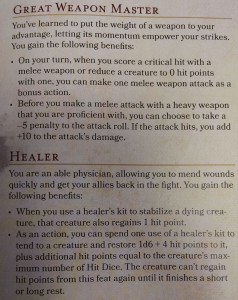 The classes received a similar treatment – there are lots of well-written inspirational passages that give a variety of ideas about what each different class can be. Class abilities have been both expanded and streamlined. For example there are now five different fighting styles, and rangers, fighters, and paladins get to chose from different subsets of the five. For the magically inclined classes spellcasting has also been simplified and made more flexible while retaining the core feel for each class. Also, some of the most popular prestige classes have been written into the core classes as options that can be chosen as the character progresses to higher levels. The cherry on top is the inclusion of the warlock class as one of the core classes. Recognizable feats have been combined and made more fun – the cleave and power attack feat takes effect on rolls of natural 20, for example. Other rules have similar dramatic effects when a 1 or a 20 is rolled.
The classes received a similar treatment – there are lots of well-written inspirational passages that give a variety of ideas about what each different class can be. Class abilities have been both expanded and streamlined. For example there are now five different fighting styles, and rangers, fighters, and paladins get to chose from different subsets of the five. For the magically inclined classes spellcasting has also been simplified and made more flexible while retaining the core feel for each class. Also, some of the most popular prestige classes have been written into the core classes as options that can be chosen as the character progresses to higher levels. The cherry on top is the inclusion of the warlock class as one of the core classes. Recognizable feats have been combined and made more fun – the cleave and power attack feat takes effect on rolls of natural 20, for example. Other rules have similar dramatic effects when a 1 or a 20 is rolled.
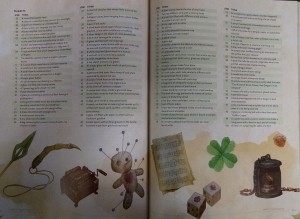 Throughout the book there are great tables and charts. Finding the trinkets chart, for example, just thrilled me. What a great resource to inspire players and DMs! And there are nods there, as well as through the rest of the book, to great classic D&D adventures and supplements I’ve played with such as The Temple of Elemental Evil. When looking for inspiration, trying to create your first dungeon, or just rolling random encounters and treasure, a evocative table to roll or pick from is a great tool. I’m glad they included lots of them.
Throughout the book there are great tables and charts. Finding the trinkets chart, for example, just thrilled me. What a great resource to inspire players and DMs! And there are nods there, as well as through the rest of the book, to great classic D&D adventures and supplements I’ve played with such as The Temple of Elemental Evil. When looking for inspiration, trying to create your first dungeon, or just rolling random encounters and treasure, a evocative table to roll or pick from is a great tool. I’m glad they included lots of them.
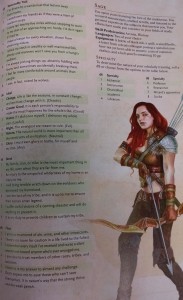 The excellent writing continues in the character details chapter, which covers description, values, bonds, flaws, alignment, backgrounds, feats, and inspiration. The backgrounds feature is a great innovation – players pick one of the many backgrounds, such as folk hero, noble, or acolyte, and that background confers skill and tool proficiency along with other character features. Each background has plenty of example prompts to inspire some creative storytelling for your character. It’s a huge improvement, in terms of player experience, over the skill point system which was always one of the most tedious parts of character creation in my opinion. Now players can just pick one background that confers a group of related skills and be done with it. Since your choice is not tied to your class players get to have a bit more variety in their characters. For those who prefer to craft something individual and different there are rules for that as well.
The excellent writing continues in the character details chapter, which covers description, values, bonds, flaws, alignment, backgrounds, feats, and inspiration. The backgrounds feature is a great innovation – players pick one of the many backgrounds, such as folk hero, noble, or acolyte, and that background confers skill and tool proficiency along with other character features. Each background has plenty of example prompts to inspire some creative storytelling for your character. It’s a huge improvement, in terms of player experience, over the skill point system which was always one of the most tedious parts of character creation in my opinion. Now players can just pick one background that confers a group of related skills and be done with it. Since your choice is not tied to your class players get to have a bit more variety in their characters. For those who prefer to craft something individual and different there are rules for that as well.
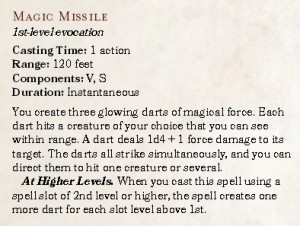 The magic section includes all the expected spells, and some new ones from 4th edition. The spells are simple and clear, most a few short paragraphs long, and the mechanics for increasing the power of lower-level spells are great. Using a higher level spell slot boosts the power of most spells in a nice, linear way. Spellcasting classes have 0th level cantrips they can cast an unlimited number of times, but because the hit point and damage totals are lower than they were in 4th edition, players shouldn’t have to actually cast them an unlimited number of times any more (sorry, 4th edition. That’ll be the only joke I make about you). Even spells that have been tricky or confusing to some in previous editions , such as Dispel Magic, have been streamlined and given more flexibility. Spells are one of the most important aspects of Dungeons & Dragons and the authors have done a great job with them.
The magic section includes all the expected spells, and some new ones from 4th edition. The spells are simple and clear, most a few short paragraphs long, and the mechanics for increasing the power of lower-level spells are great. Using a higher level spell slot boosts the power of most spells in a nice, linear way. Spellcasting classes have 0th level cantrips they can cast an unlimited number of times, but because the hit point and damage totals are lower than they were in 4th edition, players shouldn’t have to actually cast them an unlimited number of times any more (sorry, 4th edition. That’ll be the only joke I make about you). Even spells that have been tricky or confusing to some in previous editions , such as Dispel Magic, have been streamlined and given more flexibility. Spells are one of the most important aspects of Dungeons & Dragons and the authors have done a great job with them.
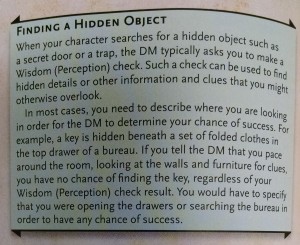 In an admirable move, Wizards of the Coast has released the basic rules for free as a PDF. It includes rules for playing a human, dwarf, elf or halfling and cleric, fighter, rogue and wizard, and about as many spells as were in the AD&D PHB. http://dnd.wizards.com/articles/features/basicrules?x=dnd/basicrules
In an admirable move, Wizards of the Coast has released the basic rules for free as a PDF. It includes rules for playing a human, dwarf, elf or halfling and cleric, fighter, rogue and wizard, and about as many spells as were in the AD&D PHB. http://dnd.wizards.com/articles/features/basicrules?x=dnd/basicrules
In conclusion I will say that I’m really looking forward to giving this new set of rules a spin. The writers at Wizards of the Coast have produced a new edition of the game that looks to have gotten the rules out of the way so that we can focus on the exciting stories we’re trying to tell. Keep watching this spot on Claw / Claw / Bite for more impressions as we play.
Posted in 5th edition Dungeons & Dragons, Editorial, Review and tagged Fantasy by Adam A. Thompson with 2 comments.
Elder Scrolls Online Beta and Online Fantasy Games
I had the opportunity to play in Bethesda Softwork’s beta test of Elder Scrolls Online this weekend and, frequent crashes of the client aside, I liked the game quite a bit. The user interface was so good, in fact, that it started me thinking about all the other online fantasy games I play. So in this post I’ll start of with my impressions from Elder Scrolls Online and move on to compare and contrast with World of Warcraft, Dungeons & Dragons Online, and Minecraft.
Elder Scrolls Online follows confidently in the footsteps of Skyrim, Oblivion, and Morrowind. The familiar world of Tamirel is good looking and well rendered. The small island I ended up stuck on was large enough to get lost on several times, so the sense of being in a large world in the game is present. The quests and NPC reactions were well voice-acted and easy to navigate, thanks to the game’s very good quest, map, and inventory interfaces. So to end the introductions, here is Sagulot.
Most of these screenshots were in the game’s low graphics mode, by the way. It looked nicer in the high mode the client started in by default, but my computer, trustworthy as it is, isn’t exactly cutting-edge. I had also heard that the client liked to crash. So I tried the minimum graphics mode, which played smoothly, and then switched it up to low, which was also very smooth. When I switched to the medium video settings, the quality of the detail improved dramatically, but it also slowed down a bit. It was still playable – I could quest and fight successfully, but it wasn’t quite a fluid as it was on the low setting. I didn’t try any settings higher than that. I know the limits of my old frugally home built desktop. Here’s a shot of it with the medium settings.
The user interface, overall, was the most impressive part of the experience, showing the type of polish in a game that, in my opinion, sets Bethesda Softworks up there as rightly-honored veterans in the video game industry. For example – the spell and special-ability hotkeys are Q, 1, 2, 3, 4, and R on the keyboard, conveniently close to the WASD movement keys. The open-doors-and-loot-chests-and-talk-to-people button, the E key, is your “accept” or “equip” key when you’re in most dialouge windows. And the ALT key is “cancel” when you want to get out of any sub-screen. Overall it makes playing the game vastly easier and is the type of attention to detail that I really appreciate in a game. If you zoom out of the first-person point of view that is the default, it moves up over your character’s right shoulder and looks down at an angle, so that you can still see things that are right in front of you. All together it helps with the immersiveness of the game.
Little touches like the lockpicking mini-game and the various disguises you can use during quests make the cloak and dagger elements fun in a way great games like Mass Effect 2 have used.Here is Sagulot, disguised as a servant.
Also, the client crashed a lot. This is the only reason I took a half star off of my tentative rating. And some of the quests or items were buggy – there was a chest that I could not open until I restarted the client. I didn’t mind too much, except for having to re-enter my password every time. I know some of my friends got frustrated and went back to playing Final Fantasy Online or Faster Than Light, but my thinking is that I’m getting to play this game for free, before they have released it, as part of a stress test of their servers. They are croudsourcing an important part of their quality assurance process, and I think it’s a good deal for them and for us, so I can put up with having to restart the client over and over. And there were a couple of instances of something not loading right, but nothing that I wasn’t able to overcome with a restart of the client.
The stories I played through were good. I particularly enjoyed the escape-from-the-underworld tutorial sequence, which played fast and got you right into the game. The quest and conversation sequences were direct and nicely to-the-point, and every one that I navigated was appropriately voice acted. There were good dramatic moments throughout the quests, and even some funny asides. The world is the wonderfully gritty, brutal fantasy-medieval world those who have played previous games in the Elder Scrolls series have come to know.
In terms of the pvp-free multiplayer, outdoor areas and many areas in the game’s dungeons are common areas, where other online players are there with you. In the online beta this turned the dungeons into perpetual bloodbaths where the goblins spawned as fast as the marauding players could slay them. Return to town, repair your equipment, sell your spoils, and set off on a new quest. And the landscape is dotted with quests, making wandering off into the wilderness a rewarding experience, even on the small island where I played.
Smoothly interspersed here and there are areas where your player is alone with some non-player characters to present a dramatic scene. The game seemed to have a way of keeping the in-game quest scenes private to each player, which was nice and helped with the verisimilitude of the heroic fantasy. Nothing to make a quest you just completed seem mundane like seeing forty other players being celebrated with the same quip. So, overall, I enjoyed the story elements, which were well executed, and look forward to seeing what other adventures like ahead.
Character statistics, skills, powers and spells appeared to work much like in previous Elder Scrolls games. In general, the skills you use the most advance without intruding on the hack-and-slash “first person sword-and-sorcery” thrill ride (FPS&S – to coin a phrase?). You can pick special powers, called “feats” that let you pierce your foe’s armor, or increase your defenses, and it appears most classes get access to some magic spells. I was happy to see the inclusion of their soul magic system, and look forward to making some magic enchantments, which appear to be transferable between items. My orc character’s class was Dragonknight I believe, and within a day of playing I had a flaming chain spell that pulled enemies to me, a sword swing that stunned my foes, and an iron cuirass and shield. It was awesome.
Overall, I give Elder Scrolls Online a tentative 3 1/2 stars. If the client crash issues and the few quest hiccups are fixed, I expect to play this excellent-looking addition to the series with my friends quite a bit when it comes out. But for now, Elder Scrolls Online, I bid you a good night.
As for World of Warcraft,Dungeons & Dragons Online, and Minecraft, tonight the candle burns low, so I will return to the subject in an upcoming post.
thanks, and happy gaming,
Posted in Review by Adam A. Thompson with no comments yet.
Aberoth
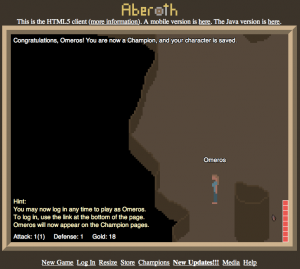
Welcome the throwback world of Aberoth, a cute little (55K) Javascript client that plugs in to what appears to be a fairly fleshed out world on the backend. It seems there are mobile clients and even one in Java (people still use Java?).
Hop online and enjoy some amusing times that will at least remind you of your old video game rpg playing days when you had more free time. If by a 1:million chance you run into me, I’m on there as Omeros.
Posted in Review by Adam A. Thompson with no comments yet.
Dungeon Robber
Last Friday, Johnn Four included a link to this fun little online dungeon generator/game, inspired by (and maybe cloned from) Gygax’s random dungeon tables. Yes, I’m just getting to fun RPG emails from last week nowish.
Posted in Review, Video Game by Stephen Hilderbrand with no comments yet.
5 Stars!
We just received a nice 5 start review for our 4th edition adventure Anointing the Seer over at RPNnow.com. Thanks, Megan!
http://rpg.drivethrustuff.com/product_reviews_info.php?reviews_id=81306&products_id=58366
Posted in Review by Adam A. Thompson with no comments yet.
Dungeons and Dragons Coloring Book
G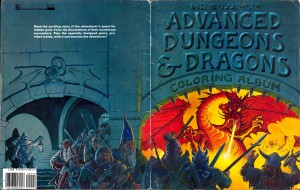 reg Irons and Gary Gygax collaborated on a dungeoneering coloring book back in 1979. The book is 30-some pages of room descriptions and lively black and white drawings that are guaranteed to inspire youngsters to color outside the lines.
reg Irons and Gary Gygax collaborated on a dungeoneering coloring book back in 1979. The book is 30-some pages of room descriptions and lively black and white drawings that are guaranteed to inspire youngsters to color outside the lines.
The nice folks at Monster Brains have posted each page as an image to Flickr, found here in a complete set. These pages have been meticulously scanned and should print well for your and your kids’ inking enjoyment. Download them now before they disappear because of some copyright lawyer’s quest for promotion!
What better way to introduce the little ones to using their minds to create worlds? Seriously, can you picture a better coloring book for an aspiring kid DM?
Images range from single, stand-alone creatures to complete scenes with aesthetic composition that spills out over the borders of the image. Note the eyestalks rising high above the fold in this sample page.
It is unclear what exactly inspired the coloring book (though the original images in all the classic DnD modules and sourcebooks share many of the features that we find in these pages. It is also unclear why there were not more of these projects. So many coloring books out there are so bland; this leaves many of them wishing they could inspire.
To celebrate this online find, and inspired by it, we are busy putting together an updated fantasy coloring book for you to zoob out to or to introduce your young broodlings to role playing while they sit in the booth at T.J. McCluckeys or wherever you find yourselves for a family dining experience.
Keep an eye tuned to Claw/Claw/Bite for sample pages and for a future release date for the full coloring book!
And, happy coloring!
Posted in Review by Adam A. Thompson with no comments yet.
Dungeonstone
Over the past 14 months, I’ve been slowly incorporating Dungeonstone into our role playing sessions, replacing handmade and Wizards-produced tiles in our more dungeon-oriented encounters. The idea has been to create more 3d effects and to provide the feeling of walls and convey the close quarters of combat better than flat tiles. 3d terrain allows players and DMs to take advantage of corners, nooks, crannies, and to use tables, chairs, and anything else as cover, which undoubtedly makes encounters more exciting and action-packed.
Until recently, I’ve been using the resin and carbon infused diestone composite terrain unpainted, which has been fine to get the basic 3d idea across. I have found that using the walls in various configurations yields interesting room properties and challenges for my players. Choke points along the corners, raised platforms in the center of the room, and the narrow passageways provided by the set help evoke high intensity on the battlefield. I’ve supplemented the terrain with my own hand-made and found additions (I’ll cover these in a follow-up post) to add additional character to our encounters.
This terrain is fully-compatible with Dwarven Forge products; I’ve mapped out a few rooms using DF’s sci-fi accessories to present futuristic dungeons full of strange equipment, and have linked Dungeonstone up to DF’s ice caverns with great success.
Now for the simple review. This product is amazing!At $100 for a 97-piece advanced set, you’ll have enough pieces to map out a few full rooms with interesting features. The basic set is $40 and comes with 43 pieces, enough to build one large room or a few small ones.
On top of all of this, the owner/sculptor/producer Leo is a nice guy; we’ve discussed his product and our respective campaigns at the past two OwlCons. He’s quick to respond to questions and has a slew of tips for making the paint stand out on his models. Paying him for his hard work and the quality of his results is only too easy; as I write this I’m considering order a few of his 4×4 and 6×6 tiles for quicker setup.
Dungeonstone is currently limited to flagstone-style dungeons; he hasn’t yet ventured into caverns or other non-standard architectures, but does have a crypt (with angled-walls, a skull-mounted wall as shown in this sample layout, and a stone sarcophagus set into a dais), wizard’s chamber (with summoning circle and rounded corners), and a working door and portcullis in his stock.
The only downside is the cost of shipping, but he takes care to wrap and pack the terrain in snug layers of paper and foam. I’ve always purchased my Dungeonstone in person, so I can’t speak to the quality of the packing post shipping, but everything I’ve read online indicates his thorough packing stands the test of modern cargo transit.
I recommend picking up a set or two from his online store at Dungeonstone.com, or at any of the cons he frequents, including at least OwlCon and ChimaeraCon. But get there early; I understand he sells out pretty quickly at these events.
Other dungeon terrain elements available in the Dungeonstone line include diagonal passageways, rounded corridors (my current favorite), rounded daises, and pre-made corridor intersections (3-way and 4-way). These go a long way toward providing a flexible dungeons assembly kit. Unfortunately, the sets don’t come with many diagonal or rounded passageways by default, but fortunately, they are available as an accessory in the online store.
My hope is that in the near future, Dungeonstone releases more large pieces to make rooms easier to assemble. Yes, larger pieces may be more difficult to store (and perhaps they are difficult to engineer as well), but these pieces allow DMs to use the smaller pieces as room accents, nooks, and other interesting room features. Other ideas for expanding the line include modular archways that rise up over the hallways and room intersections to added flair (I’ve hand-made a few of these using clay) and secret passageways that disguise well with standard walls.
In a future post, I’ll cover the painting, sealing, and mounting process that I’ve undertaken on my small yet growing collection of Dungeonstone. This will cover paint selection, techniques, and other tips for making your terrain rock.
Posted in Review and tagged Terrain by Adam A. Thompson with no comments yet.
